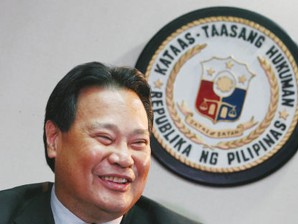Chief Justice Renato Corona on Monday claimed the Ombudsman’s order directing him to explain his purported $10 million in bank deposits was part of President Benigno Aquino III’s alleged reprisal after his family lost Hacienda Luisita in the Supreme Court’s landmark decision ordering the distribution of the sugar plantation to its workers.
“(It’s) obviously a clear retaliation for our decision on Hacienda Luisita,” Corona said in a text message to reporters.
Ombudsman Conchita Carpio Morales issued the order to Corona on April 20—four days before the tribunal handed down its final verdict affirming an earlier ruling handed down on Nov. 22, 2011, which ended the decades-old fight over the sprawling sugar plantation.
Corona vehemently denied that he was keeping multimillion-dollar deposits in different banks.
“It simply does not exist,” he said. “It’s part of the black propaganda and mind-conditioning preparatory to the resumption of (the impeachment) trial on May 7.”
Corona, who is facing an impeachment trial in the Senate for allegedly fabricating entries in his statement of assets, liabilities and net worth, said the insinuations that he had dollar accounts were “no different from the phony LRA (Land Registration Authority) list, phony US property list, phony surveys, phony letters to the Inquirer editor…”
Inquirer slammed
He accused the Philippine Daily Inquirer, which came out with the exclusive article on Morales’s order on Sunday, of colluding with the Ombudsman in publishing the story.
“Why are they putting this out in the Inquirer and not in the impeachment court?” Corona asked. “The moves of the Ombudsman and the Inquirer are obviously well-coordinated and in synch,” he said.
Corona echoed the argument of his lawyers that the Ombudsman had no jurisdiction over the Chief Justice, whose mode of ouster is specified in the Constitution, along with that of the President and other constitutional bodies.
In its April 24 ruling, the Supreme Court reaffirmed its November 22 decision, which ordered the distribution of the 4,915-hectare agricultural estate to the 6,296 registered farm worker-beneficiaries.
The court also reaffirmed its valuation of the hacienda based on its fair market value in 1989 at P40,000 per hectare, when the hacienda hammered out a stock distribution option in lieu of outright land distribution under the Comprehensive Agrarian Reform Program Mr. Aquino’s mother, the late President Corazon Aquino, launched a year earlier.
Aquino silent on program
The hacienda had sought at least P1 million per hectare, or higher, depending on the value of adjoining property and high agricultural productivity in some areas based on values in 2006 when the Department of Agrarian Reform issued a notice of coverage of the estate after the farmer-stockholders claimed their lives had not improved under the 1989 deal.
Mr. Aquino has refrained from taking a position on the court ruling, saying that he still had to receive a copy of the decision in spite of demands by the beneficiaries that his government begin the process of distribution now that the court ruling had become final and executory.
The President also has been urged to direct the Department of Social Welfare and Development to mobilize assistance to the farmers during a difficult process of transition to farmer-cultivators to show his clear intention to proceed with the agrarian reform program his mother initiated.
About 1 million ha comprising some of the most productive agricultural estates are yet to be distributed under the program scheduled to end in two years.
